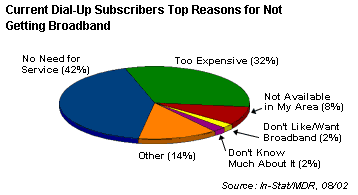| www.allensmith.net . . . [End-User Access] |
| |
| Technical >> Internet >> Individual Use >> End-User Access >> |
| "Dial-up. 2005. Read my lips.", and other quotes. |

|
 |
"In the first six months of 2003, broadband connections via cable and phone lines, leapt 18% to 23.6 million, said the Federal Communications Commission. . . .
"The US has about 170 million net users in total, say official figures. . . .
"Recent figures by industry analysts Point Topic suggest more than 30% of the world access the net over broadband, by cable and DSL."
"Are you itching to load up your e-commerce site with all the latest in animations and graphics, secure in the belief that broadband is not just coming, it has already arrived?
"I mean, you have your cable modem or DSL. Doesn't everybody?
"Think again. You might want to hold off on slowing down your load times in light of a recent study that shows most U.S. households will still be using dial-up access in the year 2005.
"Dial-up. 2005. Read my lips."
"Based on current rates of growth, less than one-third of US households will subscribe to a broadband service by 2006."

"Nearly three-quarters of the dialup Internet subscribers in the United States are content with the quality of their Internet service, which is bad news for high-speed providers trying to convince consumers to switch to broadband. . . .
" 'Broadband service providers are banking on an increasing number of these subscribers becoming frustrated with dialup service, which makes broadband seem more compelling. But if dialup customers remain pleased with the quality of Internet service at $15 to $25 per month, providers are going to have a tough time selling broadband at $45 to $50 per month.' "
Broadband Use Tracks Household Income
"In the US, the states with the highest broadband penetration also have the highest per capita income, according to the Leichtman Research Group. Massachusetts, New Jersey, New York, and Connecticut led the nation in residential penetration of high-speed Internet subscribers at the start 2003. These states also rank among the top five states in per capita income, having an average per capita income 28% above the US average, and 58% above the four states (Kentucky, Montana, South Dakota and Mississippi) with the lowest broadband penetration."
"Contrary to many Internet pundits' pronouncements, the bandwidth problem has not been solved during the last three years; nor will it be solved during the next three years. Not until 2003 will high-end users have sufficient bandwidth for acceptable Web response times. Low-end users have to wait until about 2008."
Monitor this Webpage |
Page Content Updated: December 26, 2003 |
Articles and reports on this topic provide two different sets of numbers: connections, or the number of locations in each specific access speed category; and users, or the number of people at all locations in each access speed category. (Each connection may or may not have multiple users.)